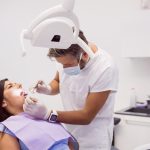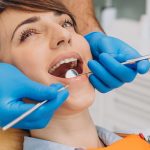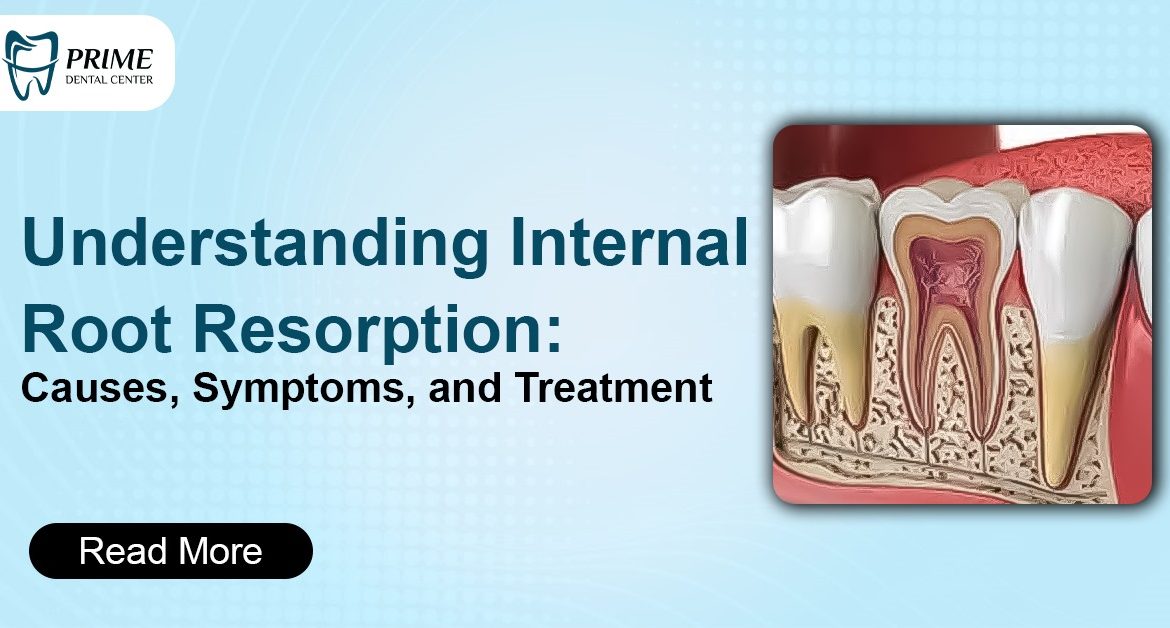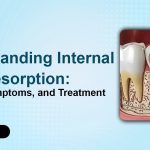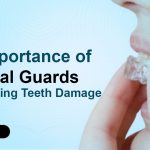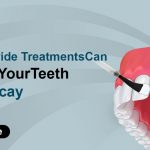The health of our teeth goes deeper than just the visible surface. Beneath the enamel and dentin lies a complex system of pulp, nerves, and blood vessels that keep the tooth alive and functional. Sometimes, however, problems can arise within the very core of the tooth, leading to conditions that are not immediately visible. One such condition is internal resorption of the root, a rare but serious issue that requires expert dental care.
At Prime Dental Center, we believe in empowering our patients with knowledge. Understanding what’s happening inside your tooth is the first step toward effective treatment and long-term oral health. This guide will walk you through what internal resorption is, what causes it, how to spot it, and how we can help you manage it.
What Is Internal Resorption of the Root?
Internal resorption is a condition where the dentin—the hard tissue layer beneath the enamel—and the cementum of a tooth’s root begin to break down from the inside out. This process is caused by specialized cells called odontoclasts, which start to eat away at the tooth’s internal structure. It often begins in the pulp chamber or root canal, the central part of the tooth containing nerves and blood vessels.
Because this breakdown occurs internally, it can go unnoticed for a long time. It is typically discovered through routine dental X-rays, where it appears as a round or oval-shaped dark spot within the tooth’s root or crown. If left untreated, the resorption can weaken the tooth significantly, potentially leading to a fracture or even tooth loss.
One distinctive sign that can sometimes be seen is the “pink spot of Mummery.” This happens when the resorption has progressed close to the tooth’s surface, and the enlarged, blood-vessel-rich pulp tissue becomes visible through the thinned enamel, giving the tooth a pinkish hue.
Common Causes of Internal Resorption
The exact trigger for internal resorption is not always clear, but it is generally linked to some form of trauma or chronic inflammation of the dental pulp. The body’s natural defense mechanisms essentially turn against the tooth itself.
Some of the most common contributing factors include:
- Physical Trauma: A significant blow to a tooth, whether recent or in the distant past, can damage the pulp and initiate the resorption process. The inflammation resulting from the injury can activate the odontoclasts.
- Chronic Pulp Inflammation (Pulpitis): Long-standing inflammation inside the tooth, often due to deep decay or extensive dental work, can create an environment where resorption begins.
- Orthodontic Treatment: In very rare cases, the pressure applied to teeth during orthodontic treatment can lead to internal resorption as a side effect.
- Cracked Teeth: A crack in the tooth can allow bacteria to seep into the pulp, causing persistent inflammation that may trigger resorption.
- Certain Dental Procedures: Extensive restorative work or procedures that affect the pulp can sometimes be a catalyst.
Symptoms to Watch For
A major challenge with internal resorption is its often silent nature in the early stages. Many patients experience no pain or noticeable symptoms, which is why regular dental check-ups are so critical for early detection.
When symptoms do appear, they can include:
- A pink or reddish discoloration on the tooth’s surface.
- Pain, which can range from a dull ache to sharp sensitivity, especially if the resorption has perforated the tooth’s structure.
- Swelling or a small bump on the gums near the affected tooth, indicating an infection.
- Increased sensitivity to hot and cold temperatures.
If you notice any of these signs, it’s essential to schedule an appointment with your dentist immediately.
Diagnosis and Treatment at Prime Dental Center
Diagnosing and treating internal resorption requires precision, advanced technology, and a deep understanding of endodontic principles. At Prime Dental Center, our team is equipped with the expertise and tools necessary to manage this complex condition effectively.
The Diagnostic Process
- Comprehensive Examination: Your visit will start with a thorough clinical examination of your teeth and gums. We will discuss your dental history, including any past injuries or significant dental work.
- Digital X-rays: Standard dental X-rays are the primary tool for detecting internal resorption. They allow us to see the internal structure of the tooth and identify any abnormal areas.
- CBCT Imaging: For a more detailed view, we may use Cone Beam Computed Tomography (CBCT). This advanced 3D imaging technology provides a cross-sectional view of the tooth, allowing us to determine the exact size, shape, and location of the resorption. This level of detail is crucial for planning the most effective treatment.
Treatment Options
The goal of treatment is to remove the inflamed pulp tissue that is causing the resorption and to save the natural tooth. The specific approach depends on the extent of the damage.
- Root Canal Therapy: For cases where the resorption is contained within the root canal system, root canal therapy is the standard treatment. During this procedure, we carefully remove the entire pulp, including the cells causing the resorption. The inside of the tooth is then cleaned, disinfected, and filled with a biocompatible material called gutta-percha. This stops the resorption process and seals the tooth from further infection.
- Surgical Intervention: If the resorption has perforated the side of the root, a surgical procedure may be necessary in addition to the root canal. This involves accessing the damaged area from the outside, repairing the defect with a special filling material, and preserving the tooth.
- Extraction: In severe cases where the resorption has caused extensive structural damage, the tooth may be too weak to save. If the tooth can’t be saved, removal might be the only solution. Following extraction, we can discuss excellent tooth replacement options like dental implants or bridges to restore your smile and function.
Your Partner in Dental Health
Internal resorption of the root can sound intimidating, but with early detection and expert care, the prognosis for saving your tooth is often very good. The key is to partner with a dental team that has the experience and technology to handle complex cases with confidence.
At Prime Dental Center, we are committed to providing you with the highest standard of care in a comfortable and professional environment. From routine check-ups that can catch problems early to advanced endodontic treatments that save natural teeth, we are here to support your oral health journey every step of the way. If you have concerns about a tooth or are overdue for a check-up, don’t wait. Contact us today to schedule your appointment.



